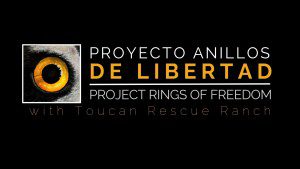Proyecto Anillos de Libertad
Toucan Rescue Ranch initiative aimed at improving the care and conservation of the birds in our Sanctuary. Birds make up nearly 50% of our yearly clinic intake, and they are the most abundant residents at the Ranch. With this project, we aim to implement practices that will elevate the care of every bird that enters our gates.
Our First Focus: Reestablishing Our Bird Banding Program
Our initial goal is to rebuild and enhance our bird banding program. Bird banding is a vital conservation tool that will help us monitor the recovery, migration, and health of the many bird species we care for. Your generous support will help us purchase essential bird bands, educate our staff, and improve the Ranch’s digital infrastructure, which will all contribute to our comprehensive avian conservation efforts.
Buy Bird Bands: Help Us Track and Protect Local Bird Populations
By donating to the Anillos de Libertad project, you play a direct role in supporting the rehabilitation and monitoring of Costa Rican bird species. Bird bands are small, but they’re a mighty tool that allows us to track migration patterns, monitor health, and assess the overall success of our release programs. These bands provide invaluable data, allowing us to evaluate the well-being of rehabilitated birds and support research that will aid in the conservation of vulnerable species. Your donation will not only support the ongoing operations at the Ranch but will also help us expand our conservation efforts.
Help Us Educate Our Staff: Bring an Expert to Our Rescue Center
Your donation can also help us bring an experienced ornithologist and certified bird bander to Toucan Rescue Ranch for an in-depth workshop on bird banding. This educational event will deepen our staff’s knowledge of the science behind bird banding and its crucial role in wildlife conservation. Your gift ensures our team is equipped with the skills needed to improve the care and tracking of the birds in our Sanctuary and fosters greater community awareness of conservation efforts.
Help Us Maintain Our Website: Track and Report Banding Activity
Supporting our website is another vital way you can contribute. The platform includes a contact form for the public to report birds found with bands issued by our center, which helps us gather real-time data on the movements and health of rehabilitated birds. This tool is essential for connecting us with our community and enabling vital conservation research. Your donation will keep our website running smoothly and help us integrate better features to support bird conservation.
Why Bird Banding?
Bird banding plays a critical role in both scientific research and conservation efforts. Here’s why it’s essential:
- Tracking Migration: Helps scientists track bird migration routes, identifying key habitats that need protection.
- Monitoring Populations: Provides data on population trends and bird health, alerting us to species that may be at risk.
- Studying Behavior: Enables detailed study of bird behavior, social dynamics, and territoriality.
- Longevity Data: Tracks the lifespan and survival rates of banded birds, giving us insights into their environmental challenges.
- Environmental Changes: Helps assess how environmental changes, like climate change and habitat loss, affect bird populations.
- Public Engagement: Serves as a tool to educate and engage the public in wildlife conservation.
What is Bird Banding?
Bird banding, or bird ringing, is a non-invasive scientific method used to monitor bird populations. It involves attaching small, uniquely numbered metal or plastic bands to a bird’s leg. These bands are issued by authorized organizations and serve as identification tools.
The process is humane: trained personnel carefully capture birds using mist nets or traps, attach the band, and then release the bird back into the wild. Information such as species, age, sex, and location is recorded, contributing valuable data to ongoing research.
How Bird Banding Will Improve Care at Toucan Rescue Ranch
Bird banding directly enhances the care and rehabilitation of the birds at our sanctuary in several ways:
- Individual Identification: Unique band numbers help staff track and monitor each bird’s progress, ensuring tailored care.
- Medical Records: Accurate banding allows for detailed medical records, ensuring proper treatment and follow-up care.
- Behavioral Monitoring: Banding helps us observe behavior changes, indicating progress or identifying potential health issues.
- Tracking Release Candidates: Banded birds can be monitored post-release, ensuring their success in rejoining wild populations.
- Research and Collaboration: The data we gather from banded birds contributes to broader research efforts and wildlife conservation initiatives.
- Public Education: Banding offers an excellent opportunity to engage the public through educational programs, increasing awareness of bird conservation.
Bird banding is not just about tracking—it’s about ensuring the future of birds in our care and those we release back into the wild. Your support directly contributes to more informed conservation practices and greater care for the incredible bird species in Costa Rica.
Make a Difference Today
Join us in supporting Anillos de Libertad. Your donation will have a lasting impact on the well-being of our birds and the success of our conservation efforts. Together, we can help give Costa Rican birds a thriving future.
Donate today and make a world of difference for these winged wonders!



